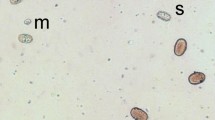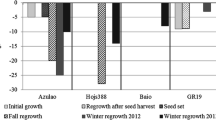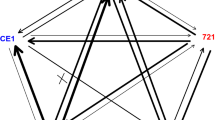Summary
The alkaloid profiles and morphological traits of the capsules of Papaver bracteatum, P. pseudo-orientale, and their hybrids were studied. Dominance of the hexaploid parent P. pseudo-orientale was observed for various characters. A genetic model assuming allelic additive effects and polysomic inheritance was elaborated for the control of isothebaine content in the capsules. The distribution of thebaine content in the segregating generations, F2 and BCF1 was evidence of the transfer of genes from the diploid parent P. bracteatum in the gametes of the interspecific hybrid and their expression in its progenies. These findings indicate the potential use of inter-specific hybrids between the Oxytona species in the breeding of cultivars for industrial or ornamental purposes.
Similar content being viewed by others
References
Böhm H (1967) Über Papaver bracteatum. III. Mitteilung charakteristischer Veränderung des Alkaloidspektrums während der Pflanzenentwicklung. Planta Med 15:215–220
Böhm H, Nixdorf H (1983) Quality and quantity of morphinan alkaloids detectable in interspecific hybrids of the genus Papaver. Planta Med 48:193–204
Fairbairn JW, Helliwell K (1975) The determination of thebaine in Papaver bracteatum by gas liquid chromatography. J Pharm Pharmacol 27:217–221
Goldblatt P (1974) Biosystematic studies in Papaver section Oxytona. Ann Mo Bot Gard 61:264–296
McNicholas LF, Martin WR (1984) New and experimental therapeutic role for naloxone and related opioid antagonists. Drugs 27:81–93
Milo J, Levy A, Ladizinsky G, Palevitch D (1988) Phylogenetic and genetic studies in Papaver section Oxytona: cytogenetics, isozyme analysis, and chloroplast DNA variation. Theor Appl Genet 75:795–802
Milo J, Levy A, Palevitch D, Ladizinsky G (1989) High performance liquid chromatographic analysis of the alkaloid spectrum in the roots and capsules of the species and hybrids of Papaver section Oxytona. J Chromatogr 452:563–570
Nyman U, Bruhn JG (1979) Papaver bracteatum — a summary of current knowledge. Planta Med 35:97–117
Ojala A, Rousi A (1986) Interspecific hybridization in Papaver. I. F1 hybrids of Papaver somniferum with perennial species of section Oxytona. Ann Bot Fenn 23: 289–303
Phillipson JD (1983) Infraspecific variation and alkaloids of Papaver species. Planta Med 48:187–192
Shafiee A, Lalezari I, Nasseri-Nauri P, Asgharian R (1975) Alkaloids of Papaver orientale and Papaver pseudo-orientale. J Pharm Sci 64: 1570–1572
Theuns HG, Janssen RHAM, Salemink CA (1987) The alkaloids of the Papaver section Oxytona Bernb. Herbs, spices, and medicinal plants. Recent Adv Bot Hortic Pharmacol 2:57–110
Author information
Authors and Affiliations
Additional information
Communicated by H. F. Linskens
Contribution No. 3066-E, 1990 series from The Agricultural Research Organization, The Volcani Center, Bet Dagan 50 250, Israel
Rights and permissions
About this article
Cite this article
Levy, A., Milo, J. Inheritance of morphological and chemical characters in interspecific hybrids between Papaver bracteatum and Papaver pseudo-orientale . Theoret. Appl. Genetics 81, 537–540 (1991). https://doi.org/10.1007/BF00219446
Received:
Accepted:
Issue Date:
DOI: https://doi.org/10.1007/BF00219446




